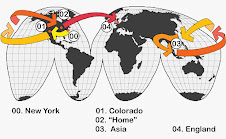
I thought it was interesting because I've never considered this before. He didn't mean which worked the best with the exchange rate or with our confusing combination of British and American banks and credit cards, but which bills and coins did I quite simply like.
The three currencies are not the same by any means. Americans use bills for all dollars aside from the occasional dollar coin, usually acquired from a vending machine or people like my father who've tried faithfully for years to increase their circulation through personal use. Coins are more of an afterthought in the USA and come in confusingly named denominations.
Yes, I actually have something to say about this and you can read about it here...
The pound and euro use bills for fives, tens, twenties, and fifties, but both have one and two pound/euro coins, rather than paper notes. At first, Josh and I found these really annoying. The pound coin is heavy, and it doesn't take long to fill a pocket or wallet with these fat pieces of metal. It's difficult to break a bill without getting back a handful of change. However, over the last year, I've grown rather attached to the pound coin; it's got a really nice weight to it. The two pounder still gets to me, though- that's four dollars (alright, lately three...) worth of coin; something's just not right there. But I like being able to pay for real goods and services with pocket change. I now figure that if I have a bill, I am probably set for the time being (plus there's always an ATM card).
While my pockets here can produce a decent haul, a handful of American change is light and small and not worth a whole lot, but it sure can fill a big jar in a very slowly satisfying way. Pound coins are too precious to be hoarded away. The smaller coin denominations are different, too. We have quarters, not twenty cent pieces as the euro and pound. I like this. Fourths just seem more logical than fifths. Plus it helps hone those simple addition skills. On the other hand, if we divide a hundred dollars into twenties, why not do the same for a hundred cents? Why not have $25 bills or 20 cent coins? There are also two pence and two cent coins, both of which seem completely useless. Just extra change.  Although I do find it puzzling that queens still exist and get put on money, at least the pound (and the euro) are colorful and not drab green. The other thing with American money is that it is terribly confusing. Why don't the coins have numbers on them? What foreigner is going to know what 'dime' or 'nickel' means? And why is the dime so much smaller than the nickel in the first place? I do like the new states quarters, though. It's fun to peer into your hand to see if you've got any new ones.
Although I do find it puzzling that queens still exist and get put on money, at least the pound (and the euro) are colorful and not drab green. The other thing with American money is that it is terribly confusing. Why don't the coins have numbers on them? What foreigner is going to know what 'dime' or 'nickel' means? And why is the dime so much smaller than the nickel in the first place? I do like the new states quarters, though. It's fun to peer into your hand to see if you've got any new ones.
Speaking of sizes, it's so much easier on the wallet that all dollar bills are the same dimensions, but would it not be so much kinder to the blind if each denomination stepped up in size as it did in worth as do the pound or the euro?
The more I write the more the pound and euro seem similar. Perhaps I'll have to do some more on-site research.I could keep going with this completely useless and rambling post, but you're probably getting bored. Let's just stop here and say I don't play favo(u)rites... money is money.
Sunday, November 30, 2008
Spare change?
Posted by
megfeen
at
8:11 AM
![]()
Subscribe to:
Post Comments (Atom)


3 comments:
If you were going to invest in one currency, which one would it be?
I LOVE LOVE LOVE the pound coin! And I miss it very much....
Eric,
Can't say I know enough about the general trends and consistencies of currencies but the Euro has been growing in strength since we've been here, while the pound is at a 10 year low against the dollar (and similar against the euro), so its got nowhere to go but up... I hope.
Post a Comment